Carbon Proofing Towards Resilient Mountain Communities – The Eco-village Scheme

Introduction
Climate change, forest loss and fragmentation, biodiversity loss, unsustainable agriculture, water pollution, degradation of natural water sources, and solid waste management, water and energy access challenges are key issues of concern in the rural areas of Himachal Pradesh. Eco-village schemes aim to address these issues by implementing environmentally sustainable practices across different sectors at village level.
The Government’s Department of Environment, Science & Technology of Himachal Pradesh (DEST), is actively engaged in the state with the objective of improving the effectiveness of environmental management, protecting vulnerable ecosystems and enhancing sustainability of development.
The department has been working in the state to bring out policies which offer inclusive development. It is also the custodian of any matters pertaining to climate change in the state and has been working closely with the Ministry of Environment, Forest & Climate Change (MoEFCC), Government of India (GoI).
The Department of Science and Technology, GoI set up Himachal Pradesh Knowledge Cell on Climate Change (HPKCCC) in DEST under the National Mission for Sustaining Himalayan Ecosystems (NMSHE) to place a sound coordination mechanism for ensuring cooperative and cohesive actions relating to climate change.
About the Eco-village Scheme: Background
The agrarian economy, with 90% of Himachal Pradesh’s population living in rural areas, is facing a great challenge due to depleting water sources, impacts on agricultural production, decrease in adaptive capacity of communities and water quality deterioration. This has further impacted the livelihoods of rural communities, which are primarilydependent on the Agriculture and Horticulture sector which is 95% rainfed dependent. Climate-induced and other natural hazards have further worsened the situation, making it difficult for the rural population to sustain their livelihoods. With water sources depleting, there is an urgent need to find ways to ensure sustainable development of the agrarian economy and make it more resilient to climate change.
The DEST developed an Eco-village Scheme with an innovative concept from 2017-18, to demonstrate a model of environmentally sustainable development in the state. The eco-village as a concept is not new, Robert Gilman set out a definition of an eco-village in 1991 that became the standard… “human-scale full-featured settlement in which human activities are harmlessly integrated into the natural world in a way that is supportive of healthy human development and can be successfully continued into the indefinite future’. So based on the current challenges and future development aspirations the eco-village scheme aims to create a self-sustaining village through the adoption of low-impact practices that create water security, food security and livelihood security for the village.
This scheme aims to actively collaborate with village-level communities, while respecting their concerns and the environment. It is still in its early stages, and in the process of evolving but has already started giving promising results in terms of improved environmental conditions and increased access to resources. The Eco-village Scheme seeks to bring together the government, local communities, and private sector partners in order to create an environment that is beneficial for all stakeholders involved.
The scheme’s goal is to promote transformative action and achieve sustainable development by implementing environmentally responsible and responsive practices in water management, waste management, energy conservation, natural resource management, climate change action, and sustainable livelihoods. This approach has assisted those stakeholders working to implement sustainable community development programmes. It also serves as a model for others to follow, bringing about a radical shift in the thinking process of the State’s communities at large, particularly in instilling environmentally responsible behaviour.
The whole scheme plans to revolve around four key elements identified as a benchmark for achieving the objectives set out to effectively implement the scheme.
Figure 1 Four key elements of a model village
For each selected Eco-Village, an Eco-Village Development Plan (EVDP) has to be prepared to be able to implement the actions as envisaged following consultations with all the stakeholders (local level) involved. The EVDP outlines the actions to be taken in a 5-year time frame for ensuring inclusive and sustainable development.
Technical Support – GIZ
GIZ India, as part of the Indo-German Technical Cooperation project “Climate Change Adaptation in Rural Areas of India (CCA RAI)” has supported the state government in bringing out the Eco-village Development Plans for two villages: Bhagalli, District Shimla and Janjheli (Bayla), District Mandi, H.P. The implementation process is being ensured by the Block Development Department.
Functional components of an Eco-village
Major components of the proposed Model Eco Village-an Environmentally Sound Sustainable Community Development are as follows.
- Protection and conservation of Natural Water Sources/ springs: Prioritizing critical springs based on their vulnerability to carry out rejuvenation through a landscape approach. Developing a detailed climate-resilient spring-shed development plan for the vulnerable springs and developing a village water security plan in the identified spring sheds.
- Adoption of Sustainable Agriculture Horticulture Practices: Crop diversification and Traditional Crops, Organic Farming and Farm Produce Management Practices.
- Water management and irrigation: Rainwater harvesting from rooftops, Revival and creation of water ponds/ maintenance of water bodies, Collection of treated wastewater for farming and minimizing water use through strict conservation practices (supply in a sustainable manner).
- Adoption of Renewable Sources of Energy: Biogas, Solar lights and heaters, and Solar fencing.
- Solid Waste Management- Cleanliness: Collection and disposal of non-biodegradable wastes, Disposal of biodegradable wastes through vermicomposting, Source segregation, composting, Reuse of some goods and materials.
- Forest Management and assured Eco Services: Community afforestation programmes, adoption of forest areas, Plantation of fruit trees in forest areas and Reduction in forest fires.
- Undertake capacity building interventions:Regular environment training, developing awareness materials and training modules for villages and identifying and setting up groups to contribute to diversity.
Challenges and ways forward
There have been challenges throughout the preparation and implementation of Eco-village Development Plans (from planning to action on the ground), ranging from assessing the local context and potential risks, understanding local needs, prioritising adaptation actions, and identifying technological and financing needs to be implemented in a time-bound frame.

Limited capacities at the local level remained a key challenge in grounding the activities. It is also important to consider how Eco-village Development Plans can be adapted for different contexts with respect to natural resource management as well as how they can be monitored and evaluated in order to ensure continued learning. Some of the learning has been as follows:
- Improving local capacities: It is critical to focus on strengthening capacities at the local level in order to identify climate, disaster and environmental risks and design appropriate strategies and identify appropriate sources of financing. The state’s training institutes have collaborated with DEST, GoHP to build capacities of the most vulnerable target groups. These include the Mahila Mandals (women farmers, members of women self-help groups etc.) and the representative of Panchayati Raj Institutions (village Self Government). These were to strengthen the role of intermediary organisations, promote gender-responsive participatory planning, foster behavioural change and enhance ownership of financing mechanisms for local needs.
- Scaling up of eco-village scheme outreach: Some of the benefits of replication and scaling model eco-village concept are the opportunity to utilise convergence of funds and schemes from different line departments at the village level. Most adaptation and environmental protection options require context specific design and implementation. Eco-village concept supports the fundamental decentralised planning of the government of India.
- Alignment of SDGs, climate and DRR requires local implementation. The Eco-village concept helps in the translation of climate, disaster and SDG priorities to the local level while providing valuable lessons for replicating and scaling up. Hence eco-village concept can act as a catalyst for local action on global and national goals and targets.
- Introducing public-private partnerships will respond to the need for stronger partnerships between the private sector, panchayats, and other communal institutions on climate adaptation, mitigation, and sustainable resource management. Investments from companies, including through their CSR (Corporate Social Responsibility) programs can provide alternate additional financing for concrete actions.
Impact of the Initiatives on the Environment & Society
Since the scheme’s official notification in 2017, DEST has been institutionalising it and sensitising district administration, block-level officers, and community representatives. So far, DEST has identified 19 eco-villages under the scheme from all 12 districts, and the EVDP is being implemented.
During the scheme’s implementation, communities were observed taking adaptation measures, identifying areas where adaptive capacity was lacking, and attempting to change and adapt to whatever was being supported. Actual on-the-ground climatic extremes experienced by people living in rural areas and rural communities are critical for our understanding of how to respond to and adapt to such conditions, as well as how this varies across different areas. This bottom-up approach is essential for addressing regional climate issues while informing a coordinated government response to climate change adaptation.
How Can Other States Follow this Model for Climate Resilience?
The Department of Environment, Science & Technology, Government of Himachal Pradesh has been pioneering in various domains at the National Level. This is from formulating an in-house State Action Plan on Climate Change (SAPCC) back in the year 2012 and banning single-use plastic and now also banning non-woven plastic carry bags of more than 60 GSM, with effect from 1 January 2023 onwards.
The Model Eco-Village Scheme has emerged as an effective model for other states to follow. The scheme is designed to help develop a sustainable eco-village in the Himalayan region, which can then be replicated in other states.

It focuses on utilizing locally available resources and following traditional methods of farming and living. The scheme also promotes the use of renewable energy sources and encourages practices like water harvesting, waste management, and organic & natural farming. By implementing this scheme, other states can benefit from reduced carbon emissions, improved air quality, increased access to clean water, improved agricultural productivity and enhanced environmental resilience over time.
Related resources
- Eco Village Development Plan - Baghali
- Eco Village Development Plan - Janjheli (Bayla)
- Climate Risk Assessment: A Pilot study in Kullu, Himachal Pradesh
- Ecosystem based Adaptation: An integrated response to climate change in the Indian Himalayan Region
- Assessing climate vulnerability and risk in the Indian Himalayan region
(0) Comments
There is no content